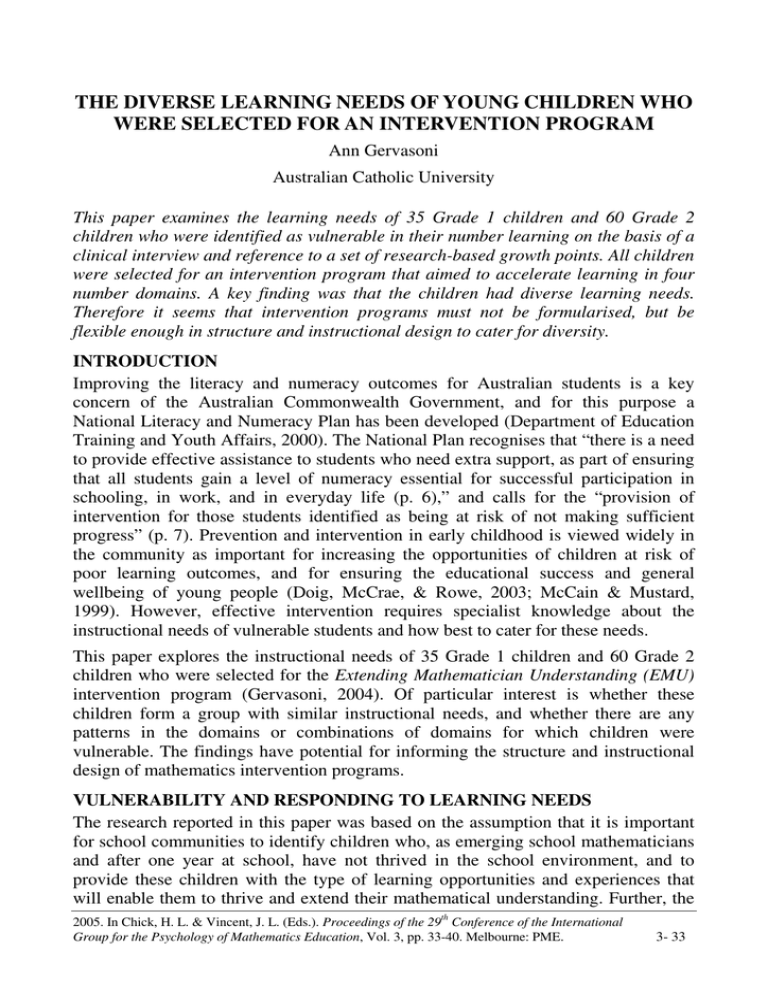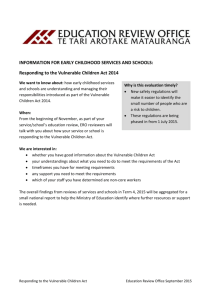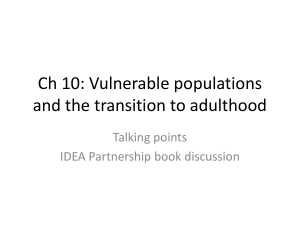THE DIVERSE LEARNING NEEDS OF YOUNG CHILDREN WHO
advertisement

THE DIVERSE LEARNING NEEDS OF YOUNG CHILDREN WHO WERE SELECTED FOR AN INTERVENTION PROGRAM Ann Gervasoni Australian Catholic University This paper examines the learning needs of 35 Grade 1 children and 60 Grade 2 children who were identified as vulnerable in their number learning on the basis of a clinical interview and reference to a set of research-based growth points. All children were selected for an intervention program that aimed to accelerate learning in four number domains. A key finding was that the children had diverse learning needs. Therefore it seems that intervention programs must not be formularised, but be flexible enough in structure and instructional design to cater for diversity. INTRODUCTION Improving the literacy and numeracy outcomes for Australian students is a key concern of the Australian Commonwealth Government, and for this purpose a National Literacy and Numeracy Plan has been developed (Department of Education Training and Youth Affairs, 2000). The National Plan recognises that “there is a need to provide effective assistance to students who need extra support, as part of ensuring that all students gain a level of numeracy essential for successful participation in schooling, in work, and in everyday life (p. 6),” and calls for the “provision of intervention for those students identified as being at risk of not making sufficient progress” (p. 7). Prevention and intervention in early childhood is viewed widely in the community as important for increasing the opportunities of children at risk of poor learning outcomes, and for ensuring the educational success and general wellbeing of young people (Doig, McCrae, & Rowe, 2003; McCain & Mustard, 1999). However, effective intervention requires specialist knowledge about the instructional needs of vulnerable students and how best to cater for these needs. This paper explores the instructional needs of 35 Grade 1 children and 60 Grade 2 children who were selected for the Extending Mathematician Understanding (EMU) intervention program (Gervasoni, 2004). Of particular interest is whether these children form a group with similar instructional needs, and whether there are any patterns in the domains or combinations of domains for which children were vulnerable. The findings have potential for informing the structure and instructional design of mathematics intervention programs. VULNERABILITY AND RESPONDING TO LEARNING NEEDS The research reported in this paper was based on the assumption that it is important for school communities to identify children who, as emerging school mathematicians and after one year at school, have not thrived in the school environment, and to provide these children with the type of learning opportunities and experiences that will enable them to thrive and extend their mathematical understanding. Further, the 2005. In Chick, H. L. & Vincent, J. L. (Eds.). Proceedings of the 29th Conference of the International Group for the Psychology of Mathematics Education, Vol. 3, pp. 33-40. Melbourne: PME. 3- 33 Gervasoni perspective that underpinned this research was that those children who have not thrived, have not yet received the type of experiences and opportunities necessary for them to construct the mathematical understandings needed to successfully engage with the school mathematics curriculum, or to make sense of the standard mathematics curriculum. As a result, these children are vulnerable and possibly at risk of poor learning outcomes. The term vulnerable is widely used in population studies (e.g., Hart, Brinkman, & Blackmore, 2003), and refers to children whose environments include risk factors that may lead to poor developmental outcomes. The challenge remains for teachers and school communities to create learning environments and design mathematics instruction that enables vulnerable children’s mathematics learning to flourish. A common theme expressed by researchers in the field of mathematics learning difficulties is the need for instruction and mathematics learning experiences to closely match children’s individual learning needs (e.g., Ginsburg, 1997; Wright, Martland, & Stafford, 2000). Rivera (1997) believes that instruction is a critical variable in effective programming for children with mathematics learning difficulties, and that instruction must be tailored to address individual needs, modified accordingly, and evaluated to ensure that learning is occurring. Ginsburg (1997) articulated a process for responding to children’s learning needs that used Vygotsky’s zone of proximal development (Vygotsky, 1978). Ginsburg’s process requires that the teacher first analyses children’s current mathematical understandings and identifies their learning potential within the zone of proximal development. For this purpose, the notion of a framework of growth points or stages of development is important for helping teachers to identify children’s zones of proximal development in mathematics, and thus identify or create appropriate learning opportunities. This approach is aligned also with the instructional principles advocated by Wright et al. (2000) for the Mathematics Recovery program. They believe that instruction for low-achieving children should be closely aligned to children’s initial and ongoing assessment, and should be at the ‘cutting edge’ of each child’s knowledge (Wright et al., 2000). The Early Numeracy Research Project (ENRP) research team also advocated this approach (Clarke, Cheeseman, Gervasoni, Gronn, Horne, McDonough, Montgomery, Roche, Sullivan, Clarke, & Rowley, 2002). Indeed, a feature of the ENRP was the use of a mathematics assessment interview and associated framework of growth points that enabled teachers to identify children’s current mathematical knowledge, and locate children’s zones of proximal development. Importantly, the assessment process also enabled those children who were vulnerable in aspects of learning mathematics to be identified. IDENTIFYING CHILDREN WHO ARE VULNERABLE In order to identify children who are vulnerable, often a line is drawn across a distribution of test scores, and children ‘below’ the line are deemed at risk and are recommended for a specialised program (Ginsburg, 1997; Woodward & Baxter, 3- 34 PME29 — 2005 Gervasoni 1997). The decision about where to ‘draw the line’ is arbitrary, but in this research was made on the basis of on the way growth points (Gervasoni, 2004). The on the way growth points relate to a framework of growth points in nine domains that were research based and drew on what was known about the course of children’s mathematical knowledge formation (Clarke, McDonough, & Sullivan, 2002; Gervasoni, 2003). The on the way growth points indicate children who have constructed the mathematical knowledge that underpins the initial mathematics curriculum in a particular domain and grade level, and who are likely to continue to learn successfully. Not yet reaching the on the way growth point in a particular domain is an indicator that children may be vulnerable in that domain and may benefit from opportunities to help them reach the on the way growth point as quickly as possible. Otherwise, they may not benefit from all classroom mathematics learning experiences because they do not have the conceptual knowledge that underpins these experiences. The development of appropriate on the way growth points for Grade 1 and 2 children was guided by three data sources: (1) the ENRP growth point distributions for 1497 Grade 1 and 1538 Grade 2 children from 34 trial schools in March 2000. These schools included Government, Catholic and Independent schools from across Victoria that were widely representative of the Victorian population; (2) the Victorian Curriculum and Standards Framework II (Board of Studies, 2000) for Grade 1 and Grade 2; and (3) the opinions of ENRP Grade 1 and Grade 2 classroom teachers (Gervasoni, 2004). The analyses and synthesis of these data resulted in the following on the way growth points being established for Grade 1 children in Counting, Place Value, Addition and Subtraction, and Multiplication and Division respectively: • • • • counting collections of at least 20 items (Growth Point 2); reading, writing, ordering and interpreting one digit numbers (Growth Point 1); counting-all in addition and subtraction situations (Growth Point 1); and counting group items as ones in multiplication and division tasks (Growth Point 1). The on the way growth points established for Grade 2 children were: • • • • counting forwards and backwards beyond 109 from any number (Growth Point 3); reading, writing, ordering and interpreting two digit numbers (Growth Point 2); counting-on in addition and subtraction situations (Growth Point 2); and using group structures to solve multiplication and division tasks (Growth Point 2). In order to determine the growth points reached by each child, their mathematics knowledge was assessed and analysed at the beginning and end of the year (March and November) using the ENRP assessment interview (Clarke, McDonough, & Sullivan, 2002), and their growth points were entered into an SPSS database (SPSS Inc., 2002). The interviews used a clinical interview approach (Ginsburg, 1997), took between 30-40 minutes for each child and were conducted by the classroom teacher. Procedures were developed and implemented to maximise consistency in interview administration across all schools (Rowley et al., 2001) in order to enhance the PME29 — 2005 3- 35 Gervasoni validity and reliability of the assessment data collected, and to ensure that the data were as consistent and as free from bias as possible. Procedures were also implemented to enhance the consistency with which the growth points were assigned (Rowley et al., 2001). This meant that a large database of reliable and valid growth point data (Rowley & Horne, 2000) that was representative of the Victorian population was available for analysis. For the purposes of this research, any children who were vulnerable in each domain were identified using a process developed by Gervasoni (2004). This involved examining children’s growth point profiles to identify those who had not reached the on the way growth points in each domain. ENRP school communities were then invited to select children for participation in an intervention program, and to train teachers to implement this program in their school. The question of interest for this paper is whether or not the children who were selected for an intervention program formed a group with similar instructional needs. Such information would be useful for preparing suitable experiences and instruction for intervention programs, and associated professional learning programs for teachers. The profiles of participating children were therefore analysed in order to identify whether there were any patterns in the domains or combinations of domains for which participating children were vulnerable. IDENTIFYING THE INSTRUCTIONAL NEEDS OF CHILDREN In 2000, 22 schools participating in the ENRP chose to implement mathematics intervention programs for their Grade 1 and Grade 2 children who were identified as vulnerable in number learning. Overall, 576 of the 1497 ENRP Grade 1 children (38%), and 659 of the 1538 ENRP Grade 2 children (43%) were identified as vulnerable in at least one number domain (Gervasoni, 2004). Of these, 35 Grade 1 children and 60 Grade 2 children from the 22 schools were selected by their communities for participation in the Extending Mathematical Understanding (EMU) intervention program. The number of children who were vulnerable in each domain is shown in Table 1. Table 1: Number of Grade 1 and Grade 2 Children Vulnerable in Each Domain. Domain Grade 1 (n=35) Grade 2 (n=60) Counting 20 (57%) 48 (80%) Place Value 14 (40%) 55 (92%) Addition and Subtraction 15 (43%) 44 (73%) Multiplication and Division 23 (66%) 32 (53%) These data highlight some important issues. First, it is clear that the participating children were not vulnerable in all domains. This may surprise some teachers. Second, a much higher percentage of Grade 2s than Grade 1s were vulnerable in 3- 36 PME29 — 2005 Gervasoni Counting, Place Value and Addition and Subtraction. This suggests that Grade 2 children were more likely than Grade 1s to be vulnerable in multiple domains. To investigate this issue, the number of domains in which children were vulnerable was calculated (see Table 2). Table 2: Number of Domains for Which Children Were Vulnerable. Domain Grade 1 (n=35) Grade 2 (n=60) Vulnerable in 1 domain 14 (40%) 4 (7%) Vulnerable in 2 domains 11 (31%) 16 (27%) Vulnerable in 3 domains 5 (14%) 17 (28%) Vulnerable in 4 domains 5 (14%) 23 (38%) The findings show that Grade 2 children were more likely to be vulnerable in 3 or 4 domains than were the Grade 1s. This comparison highlights the possibility that as children who are vulnerable in learning mathematics progress through the school, the difficulties they experience become more complex. Thus, it seems important to identify and intervene with vulnerable children as early as possible in their schooling. Figure 1 provides a diagrammatic representation of the intersecting domains for which Grade 1 children were vulnerable, and the number of children who were vulnerable in each intersecting domain. The intersections between Counting and Addition and Subtraction and Place Value and Multiplication and Division are shown with additional circles. 2 5 2 2 1 0 4 3 0 5 2 2 6 1 1 This diagram highlights two important issues. First, the diversity of domains and combinations of domains in which children were vulnerable is striking. There was a Figure 1: Diagrammatic representation of the spread of vulnerability across all domains, and there were not any intersecting domains for which Grade 1 children were vulnerable (n=35). combinations of domains that were common for the children who were vulnerable. Thus, there was no single ‘formula’ for describing these Grade 1 children who were vulnerable in learning school mathematics, or for describing the broad instructional needs of this diverse group of students. Second, most Grade 1s were vulnerable in only one or two domains, but these domains varied. PME29 — 2005 3- 37 Gervasoni Figure 2 shows the intersecting domains for which Grade 2 children were vulnerable, and the numbers of vulnerable children. The findings suggest that the learning needs of the Grade 2 group were also quite diverse. Most striking is that almost all children were vulnerable in Place Value, and also the large number of students who were vulnerable in 3 or 4 domains. In summary, these data suggest that children who are vulnerable in aspects of number learning have diverse learning needs. It is also clear that Grade 2 children were more likely to be vulnerable in multiple domains than were Grade 1 children. DISCUSSION AND IMPLICATIONS 1 2 7 1 9 5 1 7 23 3 0 0 0 0 1 Figure 2: Diagrammatic representation of the intersecting domains for which Grade 2 children were vulnerable. (n=60). The findings presented in the previous section indicate that children who participated in an intervention program have diverse learning needs, and are vulnerable in a range and combination of domains. Indeed, there was no single formula that described the instructional needs of Grades 1 and 2 children who were selected for an intervention program, and there were no patterns in the domains or in any combinations of domains for which children were vulnerable. Vulnerability was widely distributed across all four domains and combinations of domains in both grade levels. However, it was found that most, but not all, Grade 2s were vulnerable in Place Value. These findings have several implications for the structure and design of intervention programs. First, the diverse learning needs of children call for customised instructional responses from teachers. This supports the approach advocated by other researchers in the field of mathematics learning difficulties (e.g., Ginsburg, 1997; Rivera, 1997; Wright et al., 2000). It is likely that teachers will need to make individual decisions about the instructional approach for each child because there is no ‘formula’ that will meet all children’s instructional needs. This does not mean that separate intervention programs are needed for individual children, but rather that teachers need to know how to customise activities and instruction so that they may focus each child’s attention on salient features of their experiences so that they notice the aspects that lead to the construction of mathematical knowledge. For this to happen, it is optimal for group sizes to be three or less, and for teachers to be aware of each child’s current mathematical knowledge and associated zones of proximal development. This requires frequent assessment and knowledge of the ‘pathways’ of children’s learning. 3- 38 PME29 — 2005 Gervasoni The diversity of children’s mathematical knowledge across the four domains also suggests that knowledge in any one domain is not necessarily prerequisite for knowledge construction in another domain. For example, some teachers may assume that children need to be on the way in Counting before they are ready for learning opportunities in Addition and Subtraction. On the contrary, the findings presented in Figures 1 and 2 indicate that some children who are not on the way in Counting are already on the way in Addition and Subtraction, and this pattern is maintained for the other domains also. This finding has implications for the way in which the mathematics curriculum is introduced to children. It seems likely that children will benefit from learning opportunities in all four number domains, provided in tandem with one another, and that learning opportunities in one domain should not be delayed until a level of mathematical knowledge is constructed in another domain. In summary, the implications of these findings for intervention programs are: • Intervention programs need to be flexible in structure in order to meet the diverse learning needs of each participating child; • Intervention teachers need to provide instruction and feedback that is customised for the particular learning needs of each child, and based on knowledge of children’s current mathematical knowledge. Further, teachers need to draw children’s attention to the salient features of activities and learning experiences to facilitate the construction of knowledge and understanding; • Intervention programs need to focus on all number domains in tandem. It is not appropriate to wait until children reach a certain level of knowledge in one domain before another domain is introduced; and • Teachers need opportunities to gain professional knowledge about how to effectively customise learning experiences for children. CONCLUSION The findings presented in this paper highlight the diversity of domains and combinations of domains in which Grade 1 and Grade 2 children who participated in a mathematics intervention program were vulnerable, and the associated challenge teachers face to tailor instruction to meet each child’s learning needs. Clearly, intervention programs need to be flexible enough to cater for diversity. This research also found that Grade 2 children were more likely than Grade 1s to be vulnerable in 3 or 4 number domains. An implication of this finding is that it is important to provide intervention programs for children who are vulnerable as early in their schooling as possible, before their difficulties increase in complexity. Meeting the diverse learning needs of children is a challenge, and requires teachers who are knowledgeable about how to effectively identify each child’s learning needs and customise instruction accordingly. Assisting teachers to gain this knowledge is an important pursuit for school systems wanting to improve numeracy outcomes for students. PME29 — 2005 3- 39 Gervasoni References Board of Studies. (2000). Curriculum and standards framework II: Mathematics. Carlton: Author. Clarke, D., Cheeseman, J., Gervasoni, A., Gronn, D., Horne, M., McDonough, A., Montgomery, P., Roche, A., Sullivan, P., Clarke, B., & Rowley, G. (2002). Early Numeracy Research Project Final Report. Melbourne: Australian Catholic University. Clarke, B., McDonough, A., & Sullivan, P. (2002). Measuring and describing learning: The early numeracy research project. In A. Cockburn & E. Nardi (Eds), Proceedings of the 26th conference of the International Group for the Psychology of Mathematics Education (pp. 181-185), Norwich, July. Department of Education Training and Youth Affairs. (2000). Numeracy, a priority for all: Challenges for Australian schools. Canberra: Commonwealth of Australia. Doig, B., McCrae, B., & Rowe, K. (2003). A good start to numeracy: Effective numeracy strategies from research and practice in early childhood. Canberra: Commonwealth of Australia. Gervasoni, A. (2003). Key transitions in counting development for young children who experience difficulty. In N. Pateman, B. Dougherty & J. Zilliox (Eds.), Proceedings of the 2003 joint meeting of PME and PMENA (Vol. 2, pp. 421-427). Hawaii: PME. Gervasoni, A. (2004). Exploring an intervention strategy for six and seven year old children who are vulnerable in learning school mathematics. Unpublished PhD thesis, La Trobe University, Bundoora. Ginsburg, H. P. (1997). Mathematical learning disabilities: A view from developmental psychology. Journal of Learning Disabilities, 30(1), 20-33. Hart, B., Brinkman, S., & Blackmore, S. (2003). How well are we raising our children in the North Metropolitan Region? Perth: Population Health Program, North Metropolitan Heath Service. McCain, M., & Mustard, F. (1999). Reversing the real brain drain: Early years study final report. Toronto: Ontario Children's Secretariat. Rivera, D. P. (1997). Mathematics education and students with learning disabilities: Introduction to the special series. Journal of Learning Disabilities, 30(1), 2-19. Rowley, G., Gervasoni, A., Clarke, D., Horne, M., & McDonough, A. (2001). The Early Numeracy Research Project: Using interviews to monitor growth in mathematics. Paper presented at the Annual Conference of the British Educational Research Association, Leeds. Rowley, G., & Horne, M. (2000). Validation of an interview schedule for identifying growth points in early numeracy. Paper presented at the Australian Association for Research in Education Annual Conference, University of Sydney, New South Wales. SPSS Inc. (2002). SPSS for Windows (Version 11.5.0): SPSS Inc. Vygotsky, L. S. (1978). Mind in society: The development of higher mental processes. Cambridge, MA: Harvard University Press. Woodward, J., & Baxter, J. (1997). The effects of an innovative approach to mathematics on academically low-achieving students in mainstreamed settings. Exceptional Children, 63, 373-388. Wright, R., Martland, J., & Stafford, A. (2000). Early Numeracy: Assessment for teaching and intervention. London: Paul Chapman Publishing. 3- 40 PME29 — 2005




